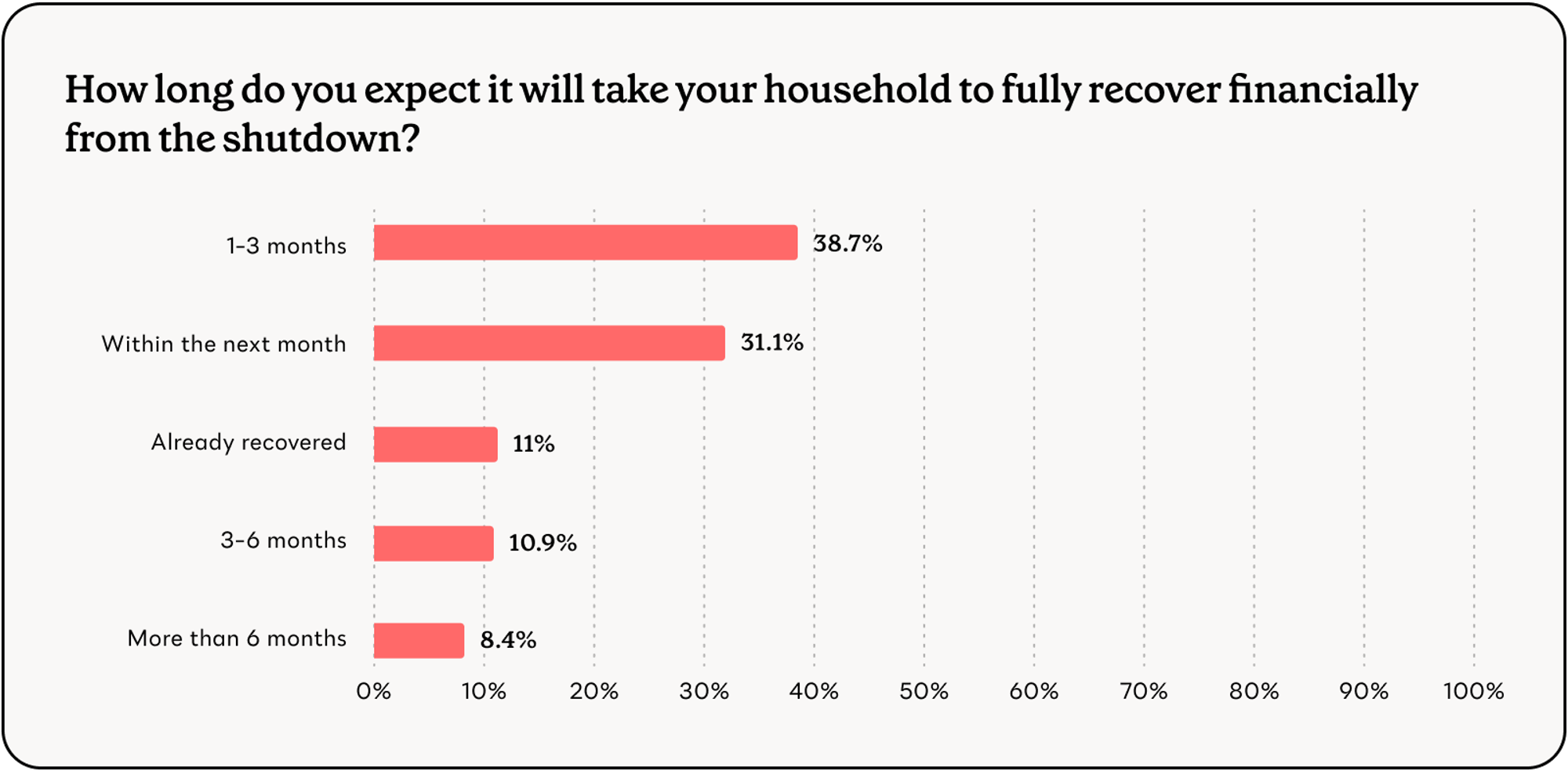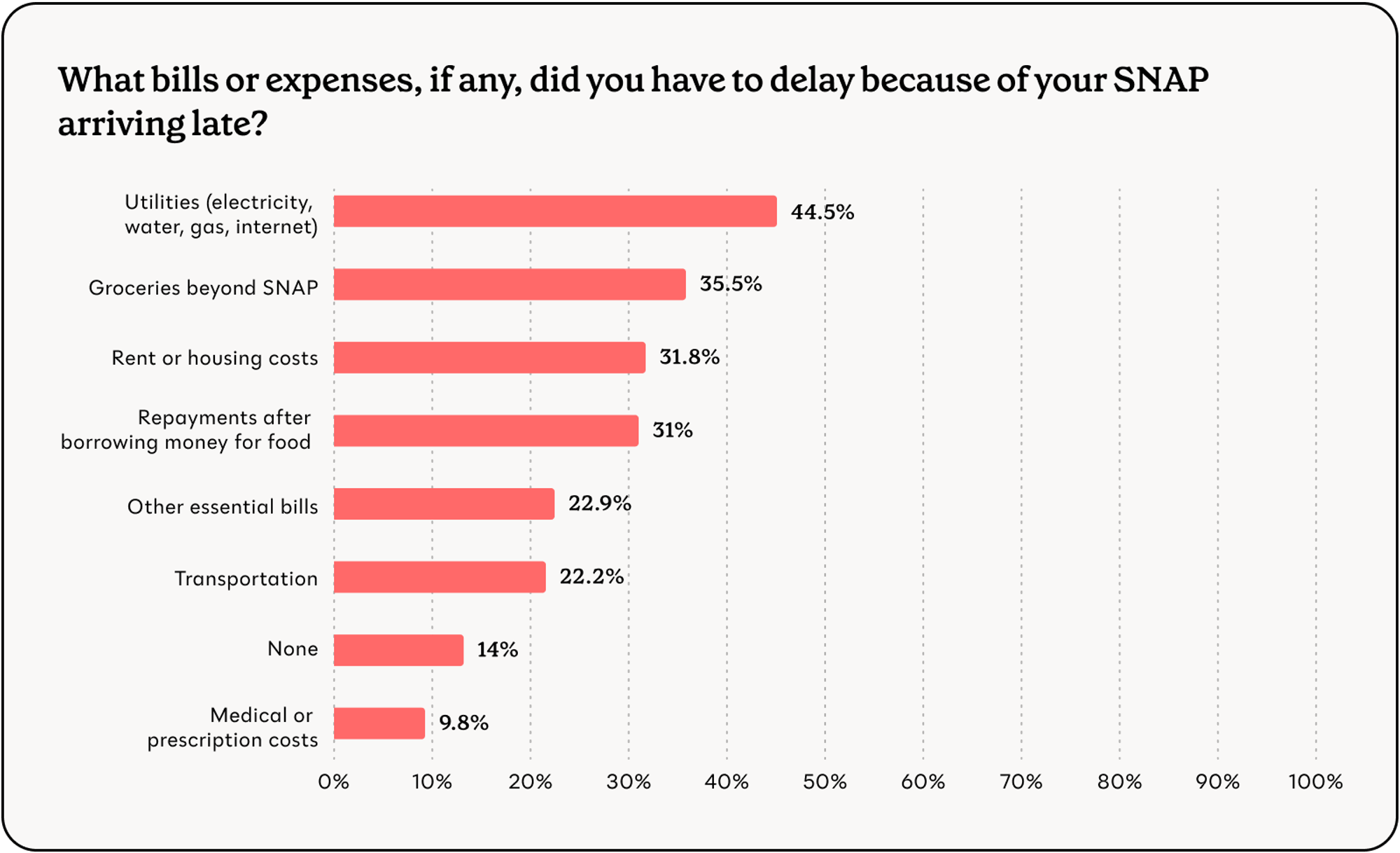Thanksgiving aftershocks: how the Shutdown is still shaping SNAP families’ Holiday plans

The federal government shutdown may have ended, but its impact is far from over. For millions of SNAP (food stamp) recipients, the early-November disruption to benefits has rippled directly into one of the most important family meals of the year: Thanksgiving.
To understand the lingering strain, Propel surveyed 1,528 SNAP recipients from November 18th and 19th, 2025 to learn how late or partial benefits affected their food security, their finances, and their holiday plans. Their responses reveal a holiday season defined by stress, sacrifice, and delayed recovery.
Many SNAP households still haven’t fully recovered from the shutdown#many-snap-households-still-havent-fully-recovered-from-the-shutdown
Although benefits eventually resumed, most households continue to feel the financial and emotional strain.
- 50% of respondents rated their stress level at the highest level (5 out of 5) when asked about affording food this month
- Nearly 40% say it will take 1–3 months for their household to fully recover financially
- An additional 8.4% anticipate recovery taking more than six months

These levels of prolonged hardship mirror concerns expressed before the shutdown, when families warned that missed benefits would push them past their breaking point.
“The shutdown has impacted my family so drastically that we are getting our car repossessed because we had to spend our car payment on formula for our 11 month old baby and food for our 2 year old. I mainly had to go without food because my husband is diabetic, he and the kids need to eat more than me.”
Evelyn, SNAP recipient
Half of families altered Thanksgiving plans due to SNAP delays#half-of-families-altered-thanksgiving-plans-due-to-snap-delays
The shutdown didn’t just strain budgets, it reshaped holiday traditions. 46.2% of families say it completely changed their Thanksgiving plans:

Confidence in being able to afford a Thanksgiving meal was also low:
- 54% were not very or not at all confident they could afford their holiday meal
- Just 12.5% felt “very confident”
These shifts echo the pre-shutdown fears captured earlier this fall, when parents worried their children would go hungry if deposits didn’t arrive on time.
“I had to spend my Thanksgiving funds for food in November to cover until we got food stamps, but now I have only enough EBT for regular food until next months deposit and I'm going to make sure I save some just in case the government shuts down again. So no Thanksgiving for this family.”
Lara, SNAP recipient
Many still lacked enough food for the week leading into Thanksgiving#many-still-lacked-enough-food-for-the-week-leading-into-thanksgiving
Nearly half of respondents (49.4%) reported they did not have enough food, benefits, or money to meet their household’s needs this week.
This mirrors the widespread reports earlier this month that many benefits did not last even two weeks under normal circumstances.
As one respondent noted:
“I’m not sure what I am able to afford. I want to ensure to cover enough food for the month and this impacts affordability for extras and covering a proper Thanksgiving meal for my family. Usually SNAP benefits assist with monthly essentials not leaving extra for anything else.”
Anonymous SNAP recipient
Families turned to survival strategies typically associated with crisis, not celebration#families-turned-to-survival-strategies-typically-associated-with-crisis-not-celebration
The week of Thanksgiving looked more like the aftermath of an emergency than the lead-up to a holiday.
Respondents reported the following coping strategies:
- 47% borrowed money or food from friends/family
- 47% visited a food pantry
- 45% bought cheaper or lower-quality food
- 43% skipped meals
- 39% delayed paying bills
These responses closely mirror strategies families shared in late October—buying cheaper food, skipping meals, visiting community organizations—underscoring that the shutdown’s effects didn’t end when the government reopened.
“With the government shutdown I had to borrow $300 from a family member and return it. So now I’m down to $300 to plan for a Thanksgiving meal for my family. I’m looking forward to finding a pantry near by that hasn’t ran out of groceries for the meal preparation.”
Anonymous SNAP recipient
Delayed SNAP benefits forced trade-offs far beyond food#delayed-snap-benefits-forced-trade-offs-far-beyond-food
Late deposits didn’t just disrupt meals, they reshaped entire household budgets.

These are the kinds of cascading financial consequences that researchers have documented among households who are farther removed from their SNAP deposit date.
“We won't be able to have a full Thanksgiving meal and due to having to use more cash than stamps so far we likely won't be able to see family for the holiday and it's cut into our Christmas shopping money as well.”
Elizabeth, SNAP recipient
The shutdown is over, but for SNAP families, the recovery is not#the-shutdown-is-over-but-for-snap-families-the-recovery-is-not
For millions of Americans, Thanksgiving is a moment of warmth, abundance, and togetherness. But for many SNAP households, this year’s holiday highlights how fragile food security becomes when even a single deposit is disrupted.
Households are still catching up on overdue bills, still borrowing from friends and family, still skipping meals—and still trying to give their families a sense of normalcy.
“I’m really hoping Thanksgiving can still feel peaceful and joyful for my family this year. I just want us to have a nice meal together, relax, and enjoy the day even if things are tight. As long as my kids are happy and we’re together, that’s what matters to me.”
Yanely, SNAP recipient